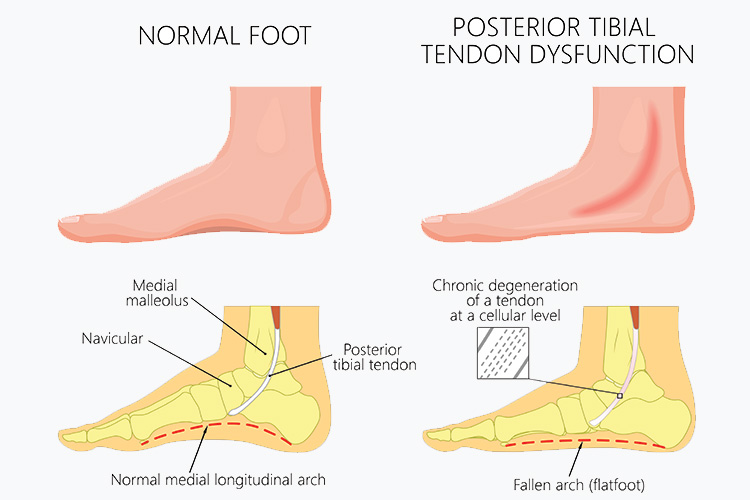Posterior Tibial Tendon Dysfunction
What Is Posterior Tibial Tendon Dysfunction (PTTD)?
If you’re feeling pain on the inside of your ankle, particularly just below the bony bump (the medial malleolus), you may have irritated your posterior tibial tendon.
The posterior tibial tendon is a fibrous cord that runs down the inside and back of your leg, passes beneath your ankle, and extends into your arch. It plays a crucial role in walking – without it, standing on your tiptoes would be difficult. When this tendon is injured, it is known as posterior tibial tendon dysfunction (PTTD).

Table of Contents
What Causes PTTD?
PTTD is often an overuse condition, occurring when excessive strain or heavy loads are placed on the posterior tibial tendon, beyond what it can safely handle. This overloading can be caused by:
- Your foot type and gait, particularly flat (pronated) feet
- Regularly wearing unsupportive footwear
- Increasing the intensity of physical activities such as hiking, running, long-distance walking, or even climbing stairs
- Working on hard floors
- Increased body weight, which places more pressure on the tendon
Symptoms
Symptoms of posterior tibial tendon dysfunction (PTTD) may include:
- Pain and tenderness on the inside of the shin, ankle, or foot
- Swelling
- Muscle aches and fatigue in the affected area
- Flattening of the affected arch
When the posterior tibial tendon is not functioning properly, it can lead to flattening of the foot, a condition known as adult acquired flat foot (AAFF).
Visit Us Today
Hope Island
Phone: 07 5510 9222
Located within Hope Island Marketplace Medical & Skin Clinic, 99-103 Broadwater Ave Hope Island QLD 4212
Jimboomba
Phone: 07 5546 9766
Located Within Jimboomba Medical Centre, Unit 1/69 Cerina Cct, Jimboomba QLD 4280
Beenleigh
Phone: 07 3287 2224
Located Within Beenleigh Mall Medical Centre, Shop24A, 40/68 Main Street, Beenleigh QLD 4207
Eagleby
Phone: 07 2889 1666
Located Within Eagleby Family Practice, 5/120 River Hills Rd, Eagleby QLD 4207
Harristown
Phone: 07 4635 6111
Located Within Toowoomba Medical Centre, 146 Drayton Road, Harristown QLD 4350
Marsden
Phone: 07 3067 2370
Located Within Marsden Family Doctors, Shop 28/55-77 Chambers Flat Rd, Marsden QLD 4132
Keperra
Phone: 07 3355 4082
Located Within Keperra Medical Clinic, 14 Dallas Parade Keperra QLD 4054
Coomera
Phone: 07 5573 5663
Located Within Doctors @ Coomera Central, Shop 6, 21 Coomera Grand Drive, Upper Coomera, QLD 4209
Newtown
Phone: 07 4633 8700
Located Within Ochre Medical Centre Wyalla, Shop 20, 238 Taylor Street, Newtown QLD 4350
Pain Progression Over Time
PTTD can be a progressive condition, with symptoms worsening over time. Here’s how the condition typically progresses:
- Early stages: Pain is felt on the inside of the foot and ankle, following the course of the tendon. The area may be red, warm, and swollen.
- As the condition worsens: The arch of the foot may begin to flatten, and there is still pain along the inside of the foot and ankle. At this stage, the foot and toes may turn outward, and the ankle rolls inward.
- If left untreated: The arch flattens further, and the pain often shifts to the outside of the foot, below the ankle. In severe cases, the tendon may tear completely.
With proper and timely treatment from your podiatrist, the progression of PTTD can be significantly slowed. In some cases, the condition may be halted completely. Treatment will vary based on the stage of the injury and may include:
- Short-term immobilisation with a moon boot or similar device
- Custom orthotics to support the arch and tendon
- Above-ankle articulation braces
- Shoe modifications or new footwear recommendations
- Stretching and strengthening exercises to rehabilitate the surrounding muscles
- Medications
- Surgery, if other treatments have not been effective
Enquire Now
Not The Condition You Are Looking For?
Find out more about the conditions we treat by clicking below.
